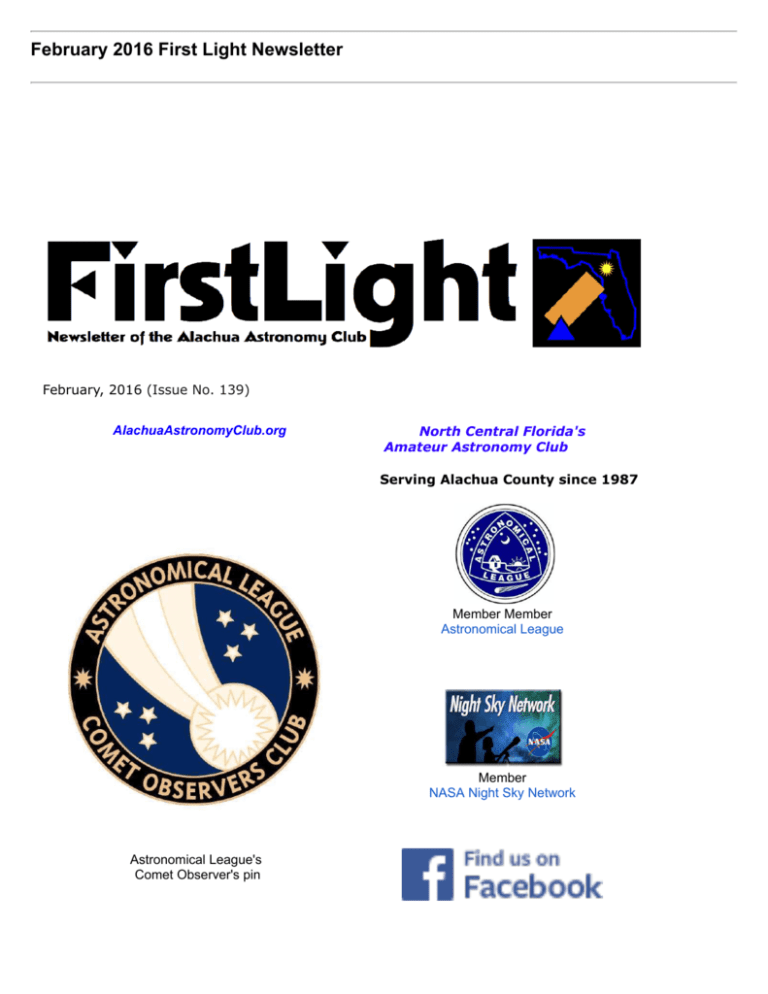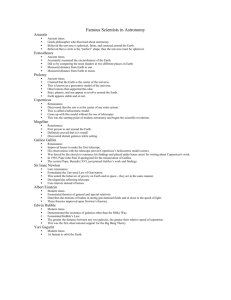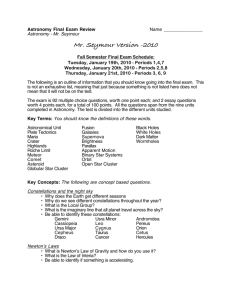
February 2016 First Light Newsletter
February, 2016 (Issue No. 139)
AlachuaAstronomyClub.org
North Central Florida's
Amateur Astronomy Club
Serving Alachua County since 1987
Member Member
Astronomical League
Member
NASA Night Sky Network
Astronomical League's
Comet Observer's pin
The Loneliest Galaxy in the Universe
by Ethan Siegel
Space Place Feature article
Our greatest, largest-scale surveys of the universe have given us an unprecedented view of cosmic structure
extending for tens of billions of light years. With the combined effects of normal matter, dark matter, dark
energy, neutrinos and radiation all affecting how matter clumps, collapses and separates over time, the great
cosmic web we see is in tremendous agreement with our best theories: the Big Bang and General Relativity.
Yet this understanding was only possible because of the pioneering work of Edwin Hubble, who identified a
large number of galaxies outside of our own, correctly measured their distance (following the work of Vesto
Slipher's work measuring their redshifts), and discovered the expanding universe.
But what if the Milky Way weren't located in one of the "strands" of the great cosmic web, where galaxies are
plentiful and ubiquitous in many different directions? What if, instead, we were located in one of the great
"voids" separating the vast majority of galaxies? It would've taken telescopes and imaging technology far more
advanced than Hubble had at his disposal to even detect a single galaxy beyond our own, much less dozens,
hundreds or millions, like we have today. While the nearest galaxies to us are only a few million light years
distant, there are voids so large that a galaxy located at the center of one might not see another for a hundred
times that distance.
While we've readily learned about our place in the universe from observing what's around us, not everyone is
as fortunate. In particular, the galaxy MCG+01-02-015 has not a single known galaxy around it for a hundred
million light years in all directions. Were you to draw a sphere around the Milky Way with a radius of 100 million
light years, we'd find hundreds of thousands of galaxies. But not MCG+01-02-015; it's the loneliest galaxy ever
discovered. Our Milky Way, like most galaxies, has been built up by mergers and accretions of many other
galaxies over billions of years, having acquired stars and gas from a slew of our former neighbors. But an
isolated galaxy like this one has only the matter it was born with to call its own.
Edwin Hubble made his universe-changing discovery using telescope technology from 1917, yet he would have
found absolutely zero other galaxies at all were we situated at MCG+01-02-015's location. The first visible
galaxy wouldn't have shown up until we had 1960s-level technology, and who knows if we'd have continued
looking? If we were such a lonely galaxy, would we have given up the search, and concluded that our galaxy
encompassed all of existence? Or would we have continued peering deeper into the void, eventually
discovering our unusual location in a vast, expanding universe? For the inhabitants of the loneliest galaxy, we
can only hope that they didn't give up the search, and discovered the entire universe.
Image credit: ESA/Hubble & NASA and N. Gorin (STScI); Acknowledgement: Judy Schmidt, of the loneliest
void galaxy in the known: MCG+01-02-015.
Newberry Star Park
by Andy Howell
The past month has been quite slow because of unfavorable observing
weather and freezing temperatures. The January star party & outreach
was canceled because of bad weather.
The biggest excitement of the month was the daytime fireball that
occurred January 24 at approximately 10:24am EST. The American
Meteor Society received 120 reports from eyewitnesses throughout
Florida and parts of Georgia, Alabama, and South Carolina. Our
Mallincam all-sky camera at NSP, which operates 24/7 was streaming live
to our web site. Undoubtedly, anyone watching the live feed would have
seen the fireball. Unfortunately, the camera was not recording to the hard drive, and we have no record of it.
(This has since been remedied, and the camera is now recording to the hard drive in case another spectacular
event like this happens again.)
The two north-facing security cameras operated by Easton Foundation at the main Easton-Newberry Sports
Complex were our next best hope for having recorded the event. Unfortunately, there was a 30 minute gap
centered on the event time! Extensive outreach to other organizations in north Florida have failed to turn up a
video of this daytime fireball.
The fireball entered earth's atmosphere in Baker County, about 15 miles northeast of Big Shoals State Park.
Doppler radar in Jacksonville received echoes from the meteor, suggesting that it dropped meteorites. Read
more about the major daytime fireball at the web site of the American Meteor Society.
http://www.amsmeteors.org/members/imo_view/event/2016/266
Star Parties
by Lisa Egar and Ivo Rabell
Stargazing at Paynes Prairie
Rescheduled for March 12, 2016
Originally scheduled for Saturday, February 6, the was canceled due to rain and clouds. Hickory Ranch is
rescheduled for March 12.
Hickory Ranch is one of the premiere events of the year, with nearly 1,000 friends and guests of Paynes Prairie
expected to be lining up through Alachua Astronomy Club telescopes.
Read more about the event at the Friends of Paynes Prairie web site.
If you haven't registered for the event, please do so HERE. Bring a sandwich, and bring your telescope! There
is no cost for AAC volunteers!
Schools and Outreach
by Mike Toomey
Our next evening school star party will be at a Gainesville elementary school on Wednesday, February 17.
(Please register online or contact me for the exact location.) We expect about 80 students along with parents
and siblings. The event will begin shortly after sunset (6:20pm). The 9 day old moon will already be high
above for immediate viewing.
On Saturday, February 27, we return to St. Madeleine's Parish near High Springs.
We may have as many as 100 visitors to this event. The official start time for
stargazing is 6:45pm; however, club members are encouraged to arrive early to
enjoy St. Madeleine's hospitality (yet to be announced but usually involves free
food!)
On Tuesday, March 1, we need some telescope operators to attend a Levy County
elementary school. We expect about 60 students to this one. The event will begin
shortly after sunset. Since there will be no moon and Jupiter will not be at a useful
elevation until the end of the program, bring your sky atlas to help you track down
a star cluster or favorite binary star. The Orion Nebula and a few other “fuzzies”
will also be easy to find without the moon's interference. [Please note, the club's
planning meeting will be rescheduled to facilitate this event.]
On Tuesday, January 19, Andy Howell and I attended the after-school 4th grade class at Caring & Sharing.
The sun was inactive so we focused on indoor activities such as crossword puzzles and meteor/meteorite
presentations. The students were well-behaved, as they typically are at C&S. The hour flew by thanks to all
the student questions. The next after-school program will be March 16.
Remember, you do not need to be an expert in astronomy to be an outreach volunteer. You do not even need
to own a telescope! You can shadow current volunteers at events, ask our Sky Mentor Bill Helms or other
members for one-on-one assistance with your telescope, or be brought up to speed with one of several clubowned telescopes. Binoculars are also excellent astronomical instruments that can be hand-held or tripodmounted.
Mike Toomey has served the AAC in many capacities since 1998, including President, Secretary, FirstLight
Editor, Star Party Coordinator and School Outreach Coordinator. Mike resides in Gainesville.
Meetings
AAC Public Meeting (past event)
Tuesday, February 9, 2016 from 7-9 p.m.
Florida Museum of Natural History
University of Florida Cultural Plaza
3215 Hull Road, Gainesville, FL 32611-2710
Speaker
Chap Percival, Astronomy Educator, Sarasota
If you missed this meeting, you missed a real treat. Chap Percival is traveling the country to promote
the August 21, 2017 total solar eclipse with the message "Go See the Eclipse! (And Take a Kid With
You)." Chap lives in Sarasota and is a lifelong educator, having taught astronomy since 1995 at Pine
View School in Osprey, Florida. Along with wife Bonnie, Chap brought along a multitude of former
students who now attend the University of Florida. Photo shows Chap Percival with five former
students who are beaming for the camera.
New Members since November 1!
Linda Andiric
Jonathan Bear
Cindy Daly
William Elliott
Basset Giles
William (Bill) Hensler
Ankur Jain
Marianne McKenzie
Jessica McLeod
Phil & Sherrie Nolden
Carlton & Leslie Oglesby
Burton (Pat) Patterson & Lena Buysse
Del Schier
President
First Light Editor
Andy Howell
Laura Wright
Ivo Rabell, the heart and soul of our
club, is recovering from a serious
medical emergency in early January.
After a month of rehabilitation, Ivo is
back home with wife Patrice and family
giving loving support.
Let me say that Ivo is an inspiration and a life lesson to
all of us about the difference that positive outlook can
have. Most of us might have been discouraged and
given up, but Ivo was determined to get back on his
feet. Through hard work and determination, he has
done so!
The same determination and gusto we've all seen Ivo
demonstrate in observing deep-sky fuzzies also
characterizes his optimisitic attitude towards work,
family, and love of learning.
The day before his release from UF Shands Rehab
Hospital, I took this photo of Ivo with another patient.
Patient M. (left) recounted what an inspiration Ivo was
to her. It's a lovely photo, and I was moved to tears by
this moment.
Comets are the subject of the Comet
Observers Program of the
Astronomical League.
According to the website "there are,
perhaps, no more wondrous and
beautiful objects as comets and they
have been known since antiquity. Since the
invention of the telescope hundreds of years ago,
astronomers have continually searched for new
comets and have discovered nebulas, star clusters,
galaxies and more in the process". "Chinese
records of Comet Halley go back to 240 BC. s of
1995, 878 comets have been cateloged and their
orbits at least roughly calculated".
Some fun facts from the website: "Comets are
sometimes called dirty snowballs. They are a
mixture of ices, both water and frozen gases, and
dust that for some reason did not get incorporated
into planets when the solar system was formed.
They are samples of the early history of the solar
system". "Comets are invisible, and not active,
except when they are near the Sun. Comets have
several distinct parts: neucleus, coma, dust tail and
ion tail".
The observing program overview lists two different
levels of observation. The Silver Level - observe at
least 12 different comets and the Gold Level observe at least 18 additional comets. Observations
may be made visually and hand sketched or by
imaging the comet.
Go to their website to learn more
www.astroleague.org
Best regards, Laura
Ivo with friend (left) and wife Patrice.
Ivo, all of us in Alachua Astronomy Club look forward
to your getting back to observing as soon as possible!
It isn't the same without you at Newberry Star Park.
Happy Valentine's Day! Each and every of our 150
members make Alachua Astronomy Club a very
special place!
The Night Sky this Month
from seasky.org
February 7 - Mercury at Greatest Western Elongation. The planet Mercury reaches greatest
western elongation of 25.6 degrees from the Sun. This is the best time to view Mercury since it
will be at its highest point above the horizon in the morning sky. Look for the planet low in the
eastern sky just before sunrise.
February 8 - New Moon. The Moon will located on the same side of the Earth as the Sun and
will not be visible in the night sky. This phase occurs at 14:39 UTC. This is the best time of the
month to observe faint objects such as galaxies and star clusters because there is no moonlight
to interfere.
February 22 - Full Moon. The Moon will be located on the opposite side of the Earth as the Sun
and its face will be will be fully illuminated. This phase occurs at 18:20 UTC. This full moon was
known by early Native American tribes as the Full Snow Moon because the heaviest snows
usually fell during this time of the year. Since hunting is difficult, this moon has also been known
by some tribes as the Full Hunger Moon, since the harsh weather made hunting difficult.
March 8 - Jupiter at Opposition. The giant planet will be at its closest approach to Earth and its
face will be fully illuminated by the Sun. It will be brighter than any other time of the year and will
be visible all night long. This is the best time to view and photograph Jupiter and its moons. A
medium-sized telescope should be able to show you some of the details in Jupiter's cloud
bands. A good pair of binoculars should allow you to see Jupiter's four largest moons, appearing
as bright dots on either side of the planet.
Copyright © 2016 Alachua Astronomy Club, Inc. All rights reserved.
Contact email: FirstLight@alachuaastronomyclub.org
Alachua Astronomy Club, Inc.
2603 NW 13th St., #161
Gainesville FL 32609-2835
Unsubscribe










